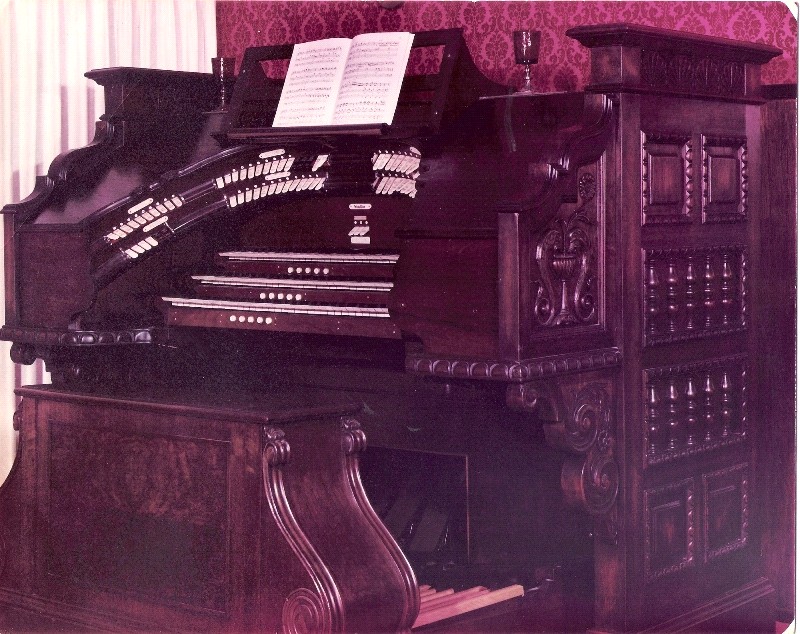RAINBOW ROOM WURLY’S SISTER ALIVE AND WELL!
Thanks to Marilyn
McNichols and Ned Niemiec for information and photos.
We can’t call
them twins, because the Rainbow Room organ was enhanced with
a second art deco
style console and roll player, but they are certainly sisters, and they both
attained a measure of fame. The Wurlitzer factory only ever built TWO Style R-16 residence organs.
The first R-16, Opus 2051, was installed in 1929 at the
Ambassador Hotel in
Factory
markings on Opus 2051’s parts, which remain to this day, confirm that the
Ambassador is where the organ was first shipped.
It then was
moved to the Goslin residence in
Somewhere
along the way, however, a more elaborate console replaced the original. Wurlitzer was known for producing straight
consoles for it’s residence organs. The 3 manual horseshoe console which now
controls this organ, is noteworthy as it has it’s own provenance and fame. It
was constructed of quarter sawn walnut with intricate carving by Italian
artisans, and a massive bench utilizing burled wood grains. For many years it
resided at the Wurlitzer factory showroom in
In 1969, Dean
McNichols bought the parts from Goslin and installed the organ, complete with
it’s new horseshoe console, at his residence in Downy California. (We do not
know what became of the original straight console at the Ambassador Hotel, the
twin to the original Rainbow Room console).

Restored Horseshoe
Console Controlling R-16 Opus 2051
McNichols Photo
Your editor
has been in touch with the widow of Dean McNichols, who kindly gave us
information about the organ. Upon acquiring the instrument, she personally
stripped and refinished the elaborate walnut horseshoe keydesk. Her husband
installed the instrument in one chamber at their home, adding a set of untuned
percussions, and a piano. After 24 years
of enjoyment, they decided to move, and sold the organ in the Fall of 1993. It
then traveled to its fourth and current home at the Ned Niemiec residence in
Conversations
with Ned Niemiec, a member of EMCATOS, the Eastern Massachusetts ATOS chapter,
indicate that he completely rebuilt the organ to
“as new” as
he installed it in one chamber at his home over a 10 year period. The organ
speaks into the listening space through a unique set of shades that he mounted
horizontally. He has added two more
tuned percussions (glock and xylophone), 2 new ranks of pipes (Welte Trumpet,
and Wurlitzer Kinura), and a toy counter. He has also added offsets to the tibia rank, extending it up to
2’, and to the tuba rank extending it down to 16’. A new tremulant, giving the
tibia rank a dedicated trem, has also been added. In the process of
respecification, Ned changed the all white stop tabs around the horseshoe to
the traditional Wurlitzer Theatre Organ colors.
Ned is in
possession of layout drawings of his R-16. It would be interesting to find out
how they compare to the Rainbow Room R-16 factory organ drawings that crew
chief Mike Fox has obtained from the Smithsonian Institution!
In effect,
Ned’s enhancements to the R-16 have served to make the instrument more
theatrical. Now, just about at the end
of his installation project (the piano still has to be hooked up, and tonal
finishing accomplished), Ned says he does not play the instrument much, has
lost interest, and is contemplating possibly selling the organ!
Photos of
this sister to the Rainbow Room organ in its current venue can be found at www.emcatos.com Click on “scrapbook”. Click on “
The second R-16, Opus 2185, built several years later, started
out as a
3 manual
residence organ demonstrator at the Wurlitzer factory. In March of 1934, with added art deco console
and roll player, it was shipped to the Rainbow Room, at 30 Rockefeller Plaza,
NYC, where it entertained visitors to the nightclub for 20 years. Around 1954 the organ was installed at the
Joe Oelhaf residence in NYC, and later was acquired by GSTOS member Lee Hulko
of
When Mike Fox
and crew complete installation of the Rainbow Room Organ at
________________________________________________________________
Article by:
John Becica
Newsletter
Editor
The North and